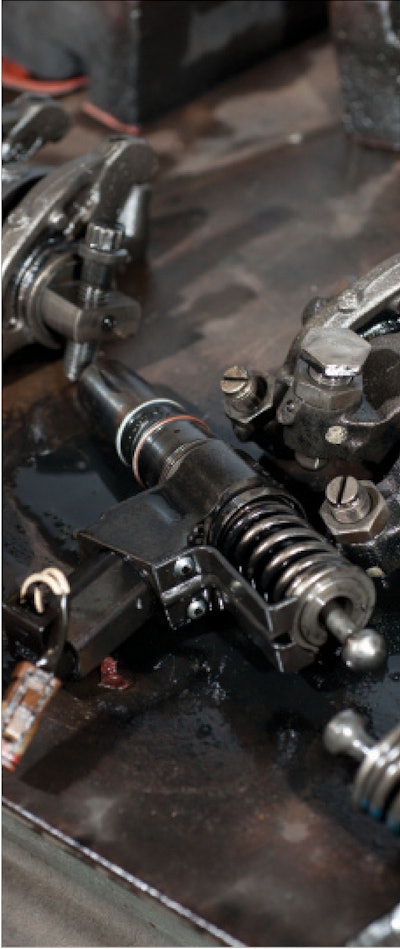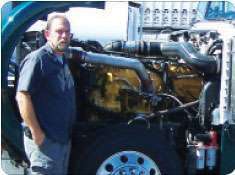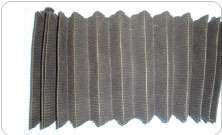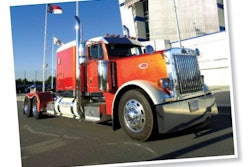Oil analysis and other information can help you determine if an engine’s ripe for rebuilding. The same diagnoses might postpone an overhaul or eliminate engine failure.
Owner-operators Don Chadwick and Wes Whitehead pull “Rocky Mountain doubles,” 40-42-foot trailers and pup trailers for Overland Petroleum in Hurricane, Utah. Their loads, delivered across eight mountainous states, frequently range more than 100,000 pounds.
 Depending on what your shop finds, replacement of selective worn parts might be a better option than an engine overhaul costing $20,000 or more.
Depending on what your shop finds, replacement of selective worn parts might be a better option than an engine overhaul costing $20,000 or more.The men, leased to MST Trucking, sustained similar roadside breakdowns caused by components being propelled through their engine blocks. Both had to be towed long distances and ended up replacing their engines. Their experiences show the difficulty of determining when to overhaul and how far you can prolong an engine’s life with overhauls.
Chadwick’s 2001 Peterbilt 379’s original engine had about 600,000 miles when it began gulping oil at about a gallon every 800 miles, he says. The engine was overhauled and lasted about 200,000 miles before it blew.
“I was driving down the freeway and could smell burning oil,” says Chadwick, an owner-operator for seven years. “When I popped the hood, there was oil running on the ground and along the side of the truck. There was a hole just behind the starter about the size of your thumbnail and oil was leaking out. They figured an aluminum piece from a piston came apart and was shoved out the side of the block.”

Whitehead had had two overhauls on his 2002 Peterbilt 379’s engine when he began hearing noises and thought he might have faulty injectors or actuators. He dropped his trailers and was heading to his repair shop in Utah, where MTS is based, when the crankshaft blew through the block.
“It had to be towed 260 miles, and the bill was just short of $3,000,” Whitehead says. He ended up paying $42,000 on that most recent rebuild, which included replacing the engine, transmission and wiring.
“People ask, ‘Why spend that?’ but I don’t want to get into a new truck,” Whitehead says. “I’ve watched the newer trucks and I don’t know if it’s worth it to get into one of them with all the emissions stuff.”
 Petroleum hauler Wes Whitehead is running on the second engine in his 2002 Peterbilt 379, after having a previous engine overhauled.
Petroleum hauler Wes Whitehead is running on the second engine in his 2002 Peterbilt 379, after having a previous engine overhauled.Distrust of post-2007 engine technology, combined with tough economic conditions and higher engine prices, has increased the demand for overhauls, the granddaddy of truck repairs. Given typical costs of $20,000 and more, it’s critical to make wise decisions about them.
Mileage alone doesn’t say much about the need for an overhaul, although engines with 750,000-800,000 miles should start getting closer scrutiny. Consistently pulling heavy loads, driving through mountains or running short haul with a lot of starts and stops will put greater stress on your engine than if you usually haul loads under 80,000 pounds cross-country. Whether the stress accumulates slowly or quickly, knowing when it’s time for an overhaul isn’t always clear-cut.
“There’s just not one thing you point to,” says Brad Williamson, project marking manager at Daimler Trucks North America. “If you feel like your truck’s just not performing like it used to in terms of power or fuel economy, it may be time.”
Two of the most effective ways to determine if the time has come are oil analysis and crankcase blow-by testing.
Oil analysis
By having an oil analysis done – at $10-$20 per sample – at every change interval, you can monitor metal concentrations and other deposits that could harm your engine. If metal particle levels are too high, this could signal a failure of the rod, main bearings or cam bearings, says Danny Long, Mack Engine product manager.
“An oil analysis will also indicate if there is a high concentration of fuel or antifreeze mixed with the oil,” he says. This could indicate failing piston rings or excessive cylinder liner wear.
Oil analysis works best if it’s done over the long term so that samples can be compared, says Dan Arcy, OEM technical manager at Shell Lubricants. If you consistently see iron, lead and copper particle readings at a low level, you’re OK. But if something goes awry and a contaminant appears, the reading will increase markedly. “The sooner you catch it, the better off you are,” Arcy says. “If you do analysis infrequently and find something, you won’t know how long the problem has existed.”
Maybe the air cleaner isn’t seated properly, allowing unfiltered air into the engine. That will show up in an oil analysis, Arcy says. “If you correct it, you may have lost a bit of life in your engine but you probably haven’t destroyed it.”
Analysis contains extensive information, but doesn’t focus on only one result, says Maria Burcham, a technical adviser with ExxonMobil Lubricants & Specialties. Instead, look at the overall report. For example, low oil viscosity and fuel dilution might signal a fuel injection system problem. Those results plus high wear metals in the sample might indicate troubles with piston rings or cylinder liners. “If your system is starting to fail, you’re going to see multiple indicators that will point you in the same direction,” she says.
Over a long period, the graph of an engine’s oil analysis readings often resembles the shape of a bathtub, says Richard Hassebrock, an engineer at Castrol Lubricants. The first few samples from a new engine might show high levels of wear metals before dropping significantly to a consistently low level. When the engine nears the end of its useful life, the readings might rise again. “Unfortunately, we live in a real world,” he says, and engine wear trends are not always so predictable.
If you choose to collect the oil sample yourself, don’t take the first drops after opening the drain, which are likely to contain debris, says Chevron Global Lubricants Direct Marketing Specialist Jim Gambill. “Let it drain for a few minutes and then take your sample,” he says. And make sure you note the mileage for the lab.
Hassebrock notes that if you’re adding oil frequently, it can sometimes mask oil analysis wear metal readings. He recommends keeping track of how much oil you’re adding and telling the lab. “I’ve had a situation where an engine failed and it wasn’t predicted,” he says.
Crankcase blow-by
As pistons and piston rings wear, they allow more compression and combustion gases to escape into the crankcase and through a rubber blow-by, or draft, tube that runs alongside the engine. As the gas increases because of worn rings or pistons, microscopically tiny oil droplets collect and eventually drip from the tube, which is a cause for concern. You might not notice until airflow blows the dripping oil across the front of the fuel tanks and under the truck. However, this may not happen on 2007 and later engines as oil droplets are filtered out of the blow-by gases before being emitted. Engine shops can test for excessive blow-by.
 The pleats of this oil filter revealed metal particles, which in some cases aren’t found in oil analysis.
The pleats of this oil filter revealed metal particles, which in some cases aren’t found in oil analysis.“The operator will also notice an increased rate of oil consumption,” says Zack Ellison, a customer support director for Cummins. “Instead of going 2,000 to 3,000 miles on a gallon of oil, they won’t make 1,000 miles. They’re starting to have significant wear inside the cylinder kits.”
Also contributing to elevated blow-by could be a leaking turbocharger seal, Ellison says. It will leak into the crankcase down the oil drain tube of the turbocharger. He says a good shop will isolate the turbocharger when troubleshooting blow-by and test the engine. Badly worn valve guides and cylinder heads can also increase crankcase blow-by. “Most of the time if you have a cylinder head or valve guide that’s worn out, you’re probably ready to do an in-frame overhaul anyway,” he says.
Wittwer says you might see gradually increasing blow-by. Don’t be alarmed, but if it increases a lot over time, have it inspected. “I’ve had lot of drivers say they’ve had excessive blow-by. All of a sudden they’re pulling a hill at night and guys behind them say it looks like their truck’s on fire. That’s when they’ve got to get something taken care of.”
How far to go
When internal damage is found early, the engine can be taken apart to see if a rebuild or replacement is in order, Mack Engines’ Long says. “If a customer decides to rebuild, he may only want to replace the rod and main bearings or perform a full rebuild,” he says.
Once the inspection has taken place, parts replacement is often wise. Rod, main and cam bearings, pistons, piston rings and liners, oil pump, thermostat and all seals and gaskets should be replaced, says Rick Cape, Mack’s remanufactured technical product manager. The water pump, injector cups and even the injectors might have to be replaced, too. At the same time, the turbocharger and items like the camshaft, rocker arms and shaft and gears should be inspected for wear, he says.
“If a rod or main bearing has failed, the crankshaft may need to be turned or polished to remove scratches made by the bearing as it failed,” Cape says. “Cylinder head work such as resurfacing, valve replacement, valve grinding and valve guide replacement should be done using new or factory-remanufactured cylinder heads.”
An experienced technician can determine if a part is worn beyond its service life.
Simple clues of engine failure
While lab and shop tests are crucial to monitoring engine wear, don’t forget more basic ways to detect engine problems. Even just sight or touch can give you clues that something might be wrong.
WATER IN THE OIL. This will manifest itself as “foam or gunk on the fill cap or neck or on the dipstick,” Richard Hassebrock of Castrol says. “Sometimes water droplets will form on the dipstick and rust will develop.”
OIL OVERHEATING. Oil that’s overheating smells like burning oil.
FUEL DILUTION. You can also smell a high level of fuel dilution. With injection system failure, fuel that isn’t fully atomized works its way past the piston rings and into the crankcase. Oil viscosity will decrease and oil will smell like fuel, Hassebrock says. “Put a drop of oil on the back of a business card and watch it spread,” he says. Rapid spreading indicates fuel.
ENGINE NOISE. Listen closely. If your engine’s pinging or running roughly, take it to the shop.
EXHAUST SMOKE. Trouble’s at hand if you see heavy smoke in the exhaust, Hassebrock says, or blue smoke with pre-2007 engines.
LOOSE SEALS. Look daily for loose seals around the intake piping that could lead to contamination of the intake track, recommends Danny Long of Mack Engine. Dirt or dust could cause premature wear of piston rings and turbochargers, thereby contaminating the oil.
ANTIFREEZE CONTAMINATION. Low cylinder compression can be a sign of worn liners, piston rings or valves, which can be caused by antifreeze contamination of the oil, Long says. Run a compression test on each cylinder to know for sure.
OIL FILTER TEST. A technician can use a special tool to cut open the filter and look for signs of metal in its pleats. Certain engine problems can produce large metal particles that aren’t found in oil analysis because they become lodged in the filter, Hassebrock says. “If you see large particles there, notify the lab to do additional analysis besides the spectrographic analysis.”
OIL PRESSURE GAUGE. While the gauge may not be perfectly calibrated, if you see a noticeable change in its reading, take action, Gambill says. “It could mean something’s wrong with the gauge, but it could also mean you’re not getting proper oil flow.”
ENGINE MILEAGE. Newer engines are built to last a million miles or more, depending on loads and driving habits. Yet most operators should be looking at an overhaul beginning at about 750,000 miles, says Jerad Wittwer, owner of Performance Diesel.
Finding a shop you can trust
Jerad Wittwer of Performance Diesel, whose shop performs four to five overhauls monthly, says if you break down on the road, don’t try to save a few bucks on the towing charge to haul your truck to the nearest shop. “Pay the extra money if you can be towed to a reputable shop,” Wittwer says.
He offers these telltale signs of a shop that does quality work:
• The shop should use new parts designated by the engine manufacturer, not aftermarket parts.
• The work should be warranted.
• The shop and its equipment should be clean and organized, with a cement floor that’s cleaned after each job. There should be a designated area, with closed doors, for overhauls.
• Tools should be up to the task, such as proper torque wrenches and a rail crane to hoist the engine.













